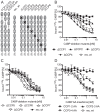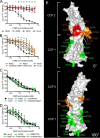Binding of complement inhibitor C4b-binding protein to a highly virulent Streptococcus pyogenes M1 strain is mediated by protein H and enhances adhesion to and invasion of endothelial cells
- PMID: 24064215
- PMCID: PMC3820857
- DOI: 10.1074/jbc.M113.502955
Binding of complement inhibitor C4b-binding protein to a highly virulent Streptococcus pyogenes M1 strain is mediated by protein H and enhances adhesion to and invasion of endothelial cells
Abstract
Streptococcus pyogenes AP1, a strain of the highly virulent M1 serotype, uses exclusively protein H to bind the complement inhibitor C4b-binding protein (C4BP). We found a strong correlation between the ability of AP1 and its isogenic mutants lacking protein H to inhibit opsonization with complement C3b and binding of C4BP. C4BP bound to immobilized protein H or AP1 bacteria retained its cofactor activity for degradation of (125)I-C4b. Furthermore, C4b deposited from serum onto AP1 bacterial surfaces was processed into C4c/C4d fragments, which did not occur on strains unable to bind C4BP. Recombinant C4BP mutants, which (i) lack certain CCP domains or (ii) have mutations in single aa as well as (iii) mutants with additional aa between different CCP domains were used to determine that the binding is mainly mediated by a patch of positively charged amino acid residues at the interface of domains CCP1 and CCP2. Using recombinant protein H fragments, we narrowed down the binding site to the N-terminal domain A. With a peptide microarray, we identified one single 18-amino acid-long peptide comprising residues 92-109, which specifically bound C4BP. Biacore was used to determine KD = 6 × 10(-7) M between protein H and a single subunit of C4BP. C4BP binding also correlated with elevated levels of adhesion and invasion to endothelial cells. Taken together, we identified the molecular basis of C4BP-protein H interaction and found that it is not only important for decreased opsonization but also for invasion of endothelial cells by S. pyogenes.
Keywords: Complement; Host-pathogen Interactions; Peptide Arrays; Protein-protein Interactions; Streptococcus pyogenes; Virulence Factors.
Figures






Similar articles
-
Human C4b-binding protein has overlapping, but not identical, binding sites for C4b and streptococcal M proteins.J Immunol. 2000 May 15;164(10):5328-36. doi: 10.4049/jimmunol.164.10.5328. J Immunol. 2000. PMID: 10799895
-
The emerging pathogen Moraxella catarrhalis interacts with complement inhibitor C4b binding protein through ubiquitous surface proteins A1 and A2.J Immunol. 2004 Oct 1;173(7):4598-606. doi: 10.4049/jimmunol.173.7.4598. J Immunol. 2004. PMID: 15383594
-
A cluster of positively charged amino acids in the alpha-chain of C4b-binding protein (C4BP) is pivotal for the regulation of the complement system and the interaction with bacteria.Scand J Clin Lab Invest Suppl. 2000;233:37-49. Scand J Clin Lab Invest Suppl. 2000. PMID: 11317941
-
Structural and functional studies of complement inhibitor C4b-binding protein.Biochem Soc Trans. 2002 Nov;30(Pt 6):978-82. doi: 10.1042/bst0300978. Biochem Soc Trans. 2002. PMID: 12440957 Review.
-
C4b-binding protein: The good, the bad and the deadly. Novel functions of an old friend.Immunol Lett. 2016 Jan;169:82-92. doi: 10.1016/j.imlet.2015.11.014. Epub 2015 Dec 2. Immunol Lett. 2016. PMID: 26658464 Review.
Cited by
-
Association of complement receptor 2 polymorphisms with innate resistance to HIV-1 infection.Genes Immun. 2015 Mar;16(2):134-41. doi: 10.1038/gene.2014.71. Epub 2015 Jan 8. Genes Immun. 2015. PMID: 25569262
-
Catch Me if You Can: Streptococcus pyogenes Complement Evasion Strategies.J Innate Immun. 2019;11(1):3-12. doi: 10.1159/000492944. Epub 2018 Sep 28. J Innate Immun. 2019. PMID: 30269134 Free PMC article. Review.
-
C4b-Binding Protein and Factor H Attenuate NLRP3 Inflammasome-Mediated Signalling Response during Group A Streptococci Infection in Human Cells.J Innate Immun. 2024;16(1):554-572. doi: 10.1159/000542434. Epub 2024 Nov 4. J Innate Immun. 2024. PMID: 39496236 Free PMC article.
-
Human IgG Increases Virulence of Streptococcus pyogenes through Complement Evasion.J Immunol. 2018 May 15;200(10):3495-3505. doi: 10.4049/jimmunol.1800090. Epub 2018 Apr 6. J Immunol. 2018. PMID: 29626087 Free PMC article.
-
Subterfuge and sabotage: evasion of host innate defenses by invasive gram-positive bacterial pathogens.Annu Rev Microbiol. 2014;68:439-58. doi: 10.1146/annurev-micro-092412-155711. Epub 2014 Jun 18. Annu Rev Microbiol. 2014. PMID: 25002085 Free PMC article. Review.
References
-
- Carapetis J. R., Steer A. C., Mulholland E. K., Weber M. (2005) The global burden of group A streptococcal diseases. Lancet Infect Dis. 5, 685–694 - PubMed
-
- Nowak R. (1994) Flesh-eating bacteria: not new, but still worrisome. Science 264, 1665. - PubMed
-
- Bisno A. L., Stevens D. L. (1996) Streptococcal infections of skin and soft tissues. N. Engl. J. Med. 334, 240–245 - PubMed
-
- Steer A. C., Law I., Matatolu L., Beall B. W., Carapetis J. R. (2009) Global emm type distribution of group A streptococci: systematic review and implications for vaccine development. Lancet Infect. Dis. 9, 611–616 - PubMed
Publication types
MeSH terms
Substances
LinkOut - more resources
Full Text Sources
Other Literature Sources
Miscellaneous

